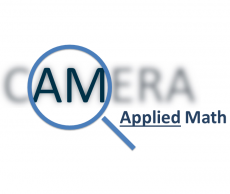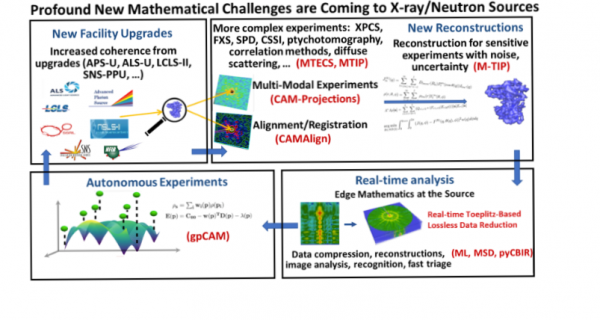 Lawrence Berkeley National Laboratory’s (Berkeley Lab’s) Center for Advanced Mathematics for Energy Research Applications (CAMERA) will receive $15 million over the next five years to expand its work developing new mathematics, algorithms, software, autonomous workflows, and real-time edge mathematics for the Department of Energy’s (DOE’s) next-generation scientific user facilities, including its X-ray light sources and neutron scattering facilities.
Lawrence Berkeley National Laboratory’s (Berkeley Lab’s) Center for Advanced Mathematics for Energy Research Applications (CAMERA) will receive $15 million over the next five years to expand its work developing new mathematics, algorithms, software, autonomous workflows, and real-time edge mathematics for the Department of Energy’s (DOE’s) next-generation scientific user facilities, including its X-ray light sources and neutron scattering facilities.
This funding comes at an opportune time; impending upgrades and sophisticated new experiments at DOE’s Advanced Light Source (ALS-U) at Berkeley Lab, the Advanced Photon Source (APS-U) at Argonne National Laboratory, the Linac Coherent Light Source-II and Stanford Synchrotron Radiation Laboratory at SLAC National Accelerator Laboratory, the National Synchrotron Light Source–II at Brookhaven National Laboratory, and the Spallation Neutron Source at Oak Ridge National Laboratory will increase coherence, detector speeds, spatial and temporal resolution, essentially creating opportunities for discovery by allowing researchers to explore matter at far deeper scales of space and time than ever before.
“These upgrades will provide tremendous new capabilities, but experiments will also become much more complicated: The data may be noisy; reconstruction is more complex; researchers want to do multiple experiments simultaneously and compare the results, and scientists want to analyze their data on the fly and adjust experiments. CAMERA is helping to build the mathematics that will allow researchers to take advantage of these powerful new experimental capabilities,” said James Sethian, CAMERA Director, Professor of Mathematics at UC Berkeley, and Mathematics Department Head in Berkeley Lab’s Applied Mathematics and Computational Research Division.

Figure Caption: Roadmap of upcoming X-ray/neutron source challenges (blue) and CAMERA algorithms (red) being developed to tackle these challenges: (Upper Left) New facility capabilities lead to (Upper Right) New experiments (CSSI, XPCS, FXS, SPD, and more) requiring new reconstruction algorithms, relying on (Lower Right) Real-time analysis via edge mathematics that encompasses machine learning, compression mathematics, and image analysis, embedded in (Lower Left) Autonomous, self-driving experiments.
CAMERA: Advancing Mathematics at DOE Facilities
Established nearly 15 years ago with support from Berkeley Lab’s Laboratory Directed Research Program, CAMERA has been a pioneer in assembling interdisciplinary teams of applied mathematicians, computer scientists, beamline scientists, materials scientists, chemists, and software engineers to develop and deliver advanced mathematical solutions to critical challenges at DOE’s Office of Basic Energy Sciences (BES) experimental facilities.
Based on CAMERA’s initial success, DOE’s Office of Advanced Scientific Computing Research (ASCR) and BES jointly invested in CAMERA as a pilot project in 2013 at the ALS facility and mathematics within Berkeley Lab’s Computing Sciences. Then, in 2015, CAMERA became a BES-ASCR project across all the light sources. Working closely with synchrotron light source partners, including the ALS, APS, NSLS-II, SLAC’s LCLS, and the Stanford Synchrotron Radiation Laboratory, CAMERA has developed several transformative mathematical tools.
For instance, researchers across the US and Europe use CAMERA’s gpCAM for autonomous data acquisition for simulations and experiments; they can easily put their domain knowledge into the steering of light source experiments and effectively find features of interest, such as materials with particularly desirable characteristics. CAMERA’s M-TIP allows researchers to use advanced mathematical techniques to determine 3D molecular structures from very sparse sets of noisy, single-particle data. Tools like CAMalign provide a new mathematical approach for joint iterative reconstruction and 3D alignment of X-ray tomography data, producing state-of-the-art, high-quality reconstructions; TomoCAM set a new world record for the fastest model-based iterative tomographic reconstruction (MBIR) code; and CAMERA’s new MTECS algorithm provides the first workable technique to extract rotational dynamics information from X-ray photon correlation spectroscopy (XPCS). Additionally, CAMERA’s machine learning tools, such as batteryNET for quickly analyzing battery performance and mixed-scale dense neural nets for tackling biological machinery, prove that CAMERA’s efforts in this space are paving the way for powerful new tools for discovery.
Solving each of these problems required developing a host of new advanced mathematical algorithms while taking into account the practical difficulties of experimental data, such as complex noise, background, misalignments, and detector artifacts.” said Jeffrey Donatelli, CAMERA Deputy Director and Mathematics for Experimental Data Analysis Group Lead in Berkeley Lab’s Applied Mathematics and Computational Research Division. “By building interdisciplinary teams including both mathematicians and experimentalists, CAMERA is able to target the development of new math and algorithms to overcome these vast experimental data analysis challenges.”
With this new round of support, CAMERA will build on its legacy of work and continue expanding on mathematical methods for autonomous experiments driven by integrated advanced reconstruction algorithms, edge mathematics for real-time analysis, and machine learning/artificial intelligence for choosing optimal experimental parameters.
CAMERA Mathematics: Reaching Across a Broader Landscape
Although this project will primarily focus on building mathematical tools for BES experimental facilities, Sethian notes these methods also benefit a variety of science domains.
For example, CAMERA is poised to provide critical mathematics for DOE’s Integrated Research Infrastructure program, which will create a seamless ecosystem for scientific research by physically connecting these state-of-the-art experimental facilities with cutting-edge high performance computers via a high-speed science network to provide a dynamic and scalable data management infrastructure to tackle the deluge of data that these upgraded experiments will produce.
“The beauty of good applied mathematics is that the solution to one challenging problem can often serve as a stepping stone to solving other problems in other fields. The fact that CAMERA researchers are contributing their mathematical expertise to two newly awarded Berkeley Lab-led Earthshot Research Centers is a prime example of this,” said Sethian. “We’re always looking for new applications and mathematical avenues, and welcome people to contact us.”
In addition to CAMERA, two other research projects were also funded to increase scientific productivity and discoveries across DOE ASCR and BES facilities: an Argonne National Laboratory-led project that addresses the technical challenges and tools needed to enhance the optimization, prediction, and experimentation capabilities at science facilities; and a SLAC-led project that focuses on the testing, delivery, and overall productive use of the research and development prototypes from all three of these projects.
About Computing Sciences at Berkeley Lab
High performance computing plays a critical role in scientific discovery. Researchers increasingly rely on advances in computer science, mathematics, computational science, data science, and large-scale computing and networking to increase our understanding of ourselves, our planet, and our universe. Berkeley Lab's Computing Sciences Area researches, develops, and deploys new foundations, tools, and technologies to meet these needs and to advance research across a broad range of scientific disciplines.

